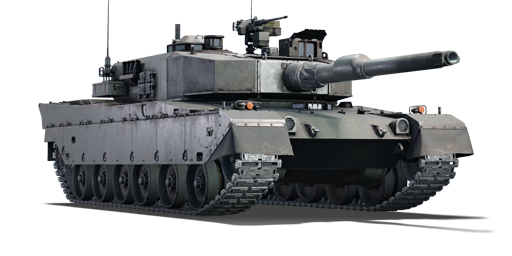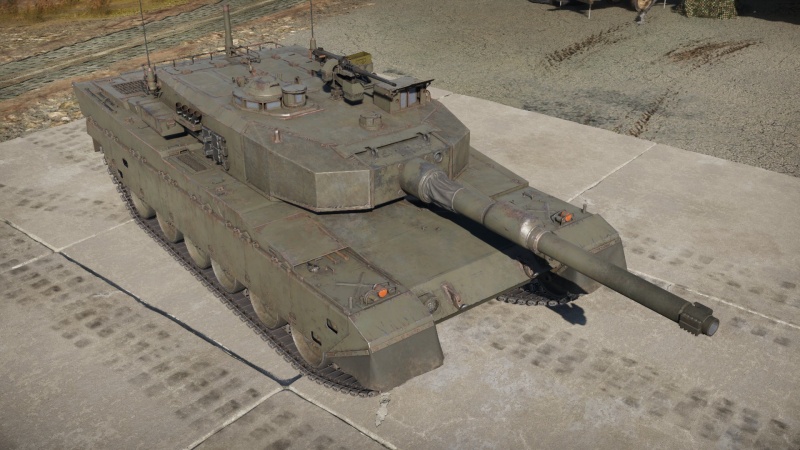Difference between revisions of "Type 90"
(Updated format) |
(→Media) |
||
| Line 290: | Line 290: | ||
== Media == | == Media == | ||
<!-- ''Excellent additions to the article would be video guides, screenshots from the game, and photos.'' --> | <!-- ''Excellent additions to the article would be video guides, screenshots from the game, and photos.'' --> | ||
| − | + | ;Skins | |
* [https://live.warthunder.com/feed/camouflages/?vehicleCountry=japan&vehicleType=tank&vehicleClass=medium_tank&vehicle=jp_type_90 Skins and camouflages for the {{PAGENAME}} from live.warthunder.com.] | * [https://live.warthunder.com/feed/camouflages/?vehicleCountry=japan&vehicleType=tank&vehicleClass=medium_tank&vehicle=jp_type_90 Skins and camouflages for the {{PAGENAME}} from live.warthunder.com.] | ||
| + | {{Skin-gallery | ||
| + | |market|ugcitem_1000299|Type 90 digital training paint.png|Camo "Digital training paint" | ||
| + | }} | ||
;Videos | ;Videos | ||
Revision as of 12:38, 11 January 2021
| This page is about the Type 90 MBT. For other usages of "Type 90", see Type 90 (Disambiguation). For the variant with mounting plates for a Type 92 Mine Roller, see Type 90 (B). |
Contents
Description
The Type 90 is a rank VII Japanese medium tank with a battle rating of 11.3 (AB/RB/SB). It was introduced in Update 1.79 "Project X".
The Type 90 MBT was initially accepted into service in 1990 as a replacement for both the Type 61 and Type 74 models. Despite its appearance being similar to the Leopard 2A4 and mounting a license produced Rheinmetall L44-based cannon, it is significantly different in a number of aspects.
General info
Survivability and armour
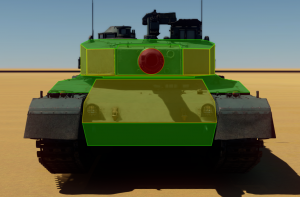
The Type 90 MBT was designed with inspiration from the Leopard 2A4, but sacrifices much of the 2A4's protection and survivability in order to attain a smaller profile and a lighter vehicle overall (vehicle weight is important in Japan in order to pass over their many bridges). As such, most 'improved' rounds available to other 10.0-10.3 MBTs (such as the Leopard 2A5's DM33, or the Leclerc's OFL 120 F1) will punch through even the Type 90's turret cheeks or upper front plate. It's important to keep in mind that even some autocannon ammunition will easily penetrate some of the weaker sections of the Type 90 from the front.
Despite the mediocre protection, the Type 90 has one main survivability feature: its primary ammunition is stored in blowout-protected compartments, sparing the crew from side shots on the rear of the turret, providing no more than 19 rounds are carried. Unfortunately, however, due to the autoloaded cannon the Type 90 is crewed by only 3, increasing the chances of being disabled from an initial shot.
| Armour | Front (Slope angle) | Sides | Rear | Roof |
|---|---|---|---|---|
| Hull | 25 mm (78°) Driver's hatch
35 mm (53-82°) Upper glacis 40 mm (50-51°) Lower glacis |
35 mm (0°) Hull
10 mm (0°) Side Skirts |
20 mm (17-70°) All rear
15 mm (0°) Engine grille |
25 mm (0-8°) Hull roof incl. engine deck
15 mm (0°) Engine grille |
| Turret | 35 mm (0-6°) Cheeks incl. Gunner optics
35 mm (1°) Mantlet 35 mm Rear Mantlet Plate |
35 mm (0°) Forward
80 mm (0°) Middle 15 mm (0°) Rear |
25 mm (0°) Turret | 35 mm (81-84°) Forehead Armour
20 mm (90°) Rear turret incl. cupola |
| Composite armour | Front | Sides | ||
| Hull | Upper glacis320 - 1100 mm Kinetic
550 - 835 mm Chemical Lower glacis 143 mm Kinetic 100 - 200 mm Chemical |
N/A | ||
| Turret | Turret cheeks400 - 450 mm Kinetic
650 - 750 mm Chemical Gun mantlet 200 - 452 mm Kinetic 260 - 530 mm Chemical |
Side forward
360 - 400 mm Kinetic 560 - 600 mm Chemical Side middle 80 mm Kinetic 80 mm Chemical | ||
Mobility
| Game Mode | Max Speed (km/h) | Weight (tons) | Engine power (horsepower) | Power-to-weight ratio (hp/ton) | |||
|---|---|---|---|---|---|---|---|
| Forward | Reverse | Stock | Upgraded | Stock | Upgraded | ||
| Arcade | 81 | 38 | 50.2 | 2032 | 2,862 | 40.48 | 57.01 |
| Realistic | 73 | 34 | 1327 | 1,500 | 26.43 | 29.88 | |
The Type 90 is powered by a 10-cylinder two-stroke diesel engine producing a maximum of 1,500 horsepower at 2400 RPM. Combined with its relatively light weight of only 51.6 tonnes, this gives it an excellent power-to-weight ratio of 29.07. As such, the Type 90 is often one of the first vehicles to reach cap points in a match, and can comfortably flank or move into advantageous positions earlier than many of its contemporaries. This power is transferred to the drive sprockets via an automatic transmission with 7 forward and 2 backward gears, unfortunately limiting the otherwise extremely mobile vehicle to 72 km/h (RB/SB) forwards and -33 km/h (RB/SB) backwards - speeds which it will reach with ease on-road.
The Type 90 also mounts hydropneumatic suspension, allowing it to actively change the vehicle's ride height and angle. This can be used to improve traction on angled surfaces.
Modifications and economy
Armaments
Main armament
The Type 90 L/44 120 mm cannon is a license-produced clone of the Rheinmetall L/44 cannon found on the Leopard 2 series and the M1A1/M1A2. As such, it shares their excellent accuracy and firepower characteristics, with a key advantage: the Type 90 is autoloaded. This results in a flat 5 second reload, better than the peak manually loaded speeds available to the other L/44-mounting vehicles (6 seconds). Additionally, reloads are not hindered by fire or the loss of crew members. The Type 90 has two rounds available to it; the powerful JM33 APFSDS round (based off the NATO DM33 round) and the JM12A1 HEAT-FS round (based off DM12A1). These rounds are more than capable of penetrating any opponent the Type 90 may face, although when facing some later vehicles such as the M1A2 or Leopard 2A5, weak points must be targeted.
| 120 mm Type 90 L/44 | Turret rotation speed (°/s) | Reloading rate (seconds) | |||||||||||
|---|---|---|---|---|---|---|---|---|---|---|---|---|---|
| Mode | Capacity | Vertical | Horizontal | Stabilizer | Stock | Upgraded | Full | Expert | Aced | Stock | Full | Expert | Aced |
| Arcade | 42 | -7°/+10° | ±180° | Two-plane | 28.6 | 39.53 | 48 | 53.08 | 56.47 | 5.0 | |||
| Realistic | 17.9 | 21 | 25.5 | 28.2 | 30.0 | ||||||||
Ammunition
| Penetration statistics | |||||||
|---|---|---|---|---|---|---|---|
| Ammunition | Type of warhead |
Penetration @ 0° Angle of Attack (mm) | |||||
| 10 m | 100 m | 500 m | 1,000 m | 1,500 m | 2,000 m | ||
| JM12A1 | HEATFS | 480 | 480 | 480 | 480 | 480 | 480 |
| JM33 | APFSDS | 481 | 478 | 470 | 461 | 450 | 440 |
| Shell details | |||||||||
|---|---|---|---|---|---|---|---|---|---|
| Ammunition | Type of warhead |
Velocity (m/s) |
Projectile Mass (kg) |
Fuse delay (m) |
Fuse sensitivity (mm) |
Explosive Mass (TNT equivalent) (g) |
Ricochet | ||
| 0% | 50% | 100% | |||||||
| JM12A1 | HEATFS | 1,140 | 13.5 | 0.0 | 0.1 | 2,150 | 65° | 72° | 75° |
| JM33 | APFSDS | 1,640 | 4.3 | N/A | N/A | N/A | 78° | 80° | 81° |
Ammo racks
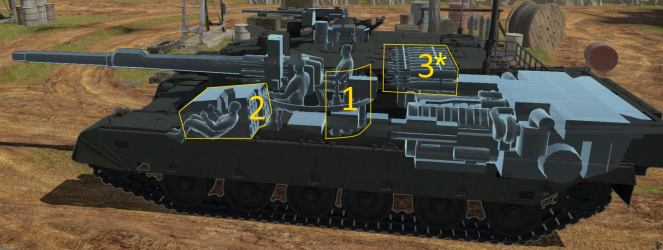
| Full ammo |
1st rack empty |
2nd rack empty |
3rd rack empty |
Recommendations | Visual discrepancy |
|---|---|---|---|---|---|
| 42 | 38 (+3) | 19 (+23) | 1 (+41) | Hull empty: 19 | No |
Optics and night vision
The Type 90 receives night vision imagers once the tier 3 modification 'NVD' is researched. This unlocks standard 500 x 300 resolution thermal sights for the gunner, as well as standard image intensifiers for all crew (available in third person view in AB/RB additionally).
| Type 90 Optics | ||||||
|---|---|---|---|---|---|---|
| Type of optic | Magnification | Night Vision Devices | ||||
| Image Intensifier | Thermal Imager Resolution |
Notes | ||||
| Resolution | Light Mult | Noise Level | ||||
| Gunner's Sight | 8.0x - 16.1x | -- | -- | -- | 500 x 300 | Intensifier & thermal sights unlocked by 'NVD' modification (tier 3) |
| Commander's View | 6.0x | 1600 x 1200 | 9.0 | High | N/A | Intensifier unlocked by 'NVD' modification (tier 3) |
| Driver's View | 1.0x | 800 x 600 | 5.0 | High | N/A | Intensifier unlocked by 'NVD' modification (tier 3) |
Machine guns
The Type 90 mounts two machine guns; one pintle-mounted 12.7 mm and one coaxial mounted 7.62 mm. These can be used as deterrent for low-flying aircraft, clearing light obstacles or crew from open-top vehicles, or spotting enemy vehicles.
| 12.7 mm M2HB | ||||
|---|---|---|---|---|
| Mount | Capacity (Belt capacity) |
Fire rate (shots/minute) |
Vertical guidance |
Horizontal guidance |
| Pintle | 1,000 (200) | 576 | -8°/+40° | ±120° |
| 7.62 mm Type 74 | ||||
|---|---|---|---|---|
| Mount | Capacity (Belt capacity) |
Fire rate (shots/minute) |
Vertical guidance |
Horizontal guidance |
| Coaxial | 4,500 (250) | 500 | N/A | N/A |
Usage in battles
The Type 90 is an extremely capable vehicle in the hands of an experienced tanker, but heed must be paid to the vehicle's weaknesses at all times.
Rural Combat
The Type 90 is very capable in rural combat where cover is plentiful and flanking routes are available. It should ideally be used for early flanks where available (such as the eastern flank on Maginot Line) or when unavailable, pushing quickly for early captures before moving to a nearby protected location to hold that point. It's important to be aware of which routes might be sniper-covered early, as many snipers (such as the Challenger 2 or Ariete PSO) will easily penetrate the Type 90, even at range - avoid giving them the opportunity.
Urban Combat
The Type 90 can prove itself to be an excellent urban combat vehicle, primarily due to its mobility and reliably fast reload. As in rural combat, an early push for a cap can prove viable before moving into a protected position, although often by the time the capture is completed enemy targets will be nearby. Early flanking (such as around the sides of American Desert) is also viable.
Notable Targets
- Challenger 2: The Challenger 2 is often found as a sniper due to its pin-point accuracy, good reload and excellent turret armour. The Type 90 should never be used to face a sniping CR2 head-on, but instead should attempt to flank or force engagements at close range where weak spots are easily targeted.
- M1A2 Abrams: The M1A2 Abrams has excellent frontal protection and can prove tricky to discern from earlier models in the heat of a battle. As a general rule it's preferable to aim for the gun mantlet or turret ring on any Abrams, despite the fact that JM33 will penetrate nearly anywhere on early models - better safe than sorry.
- Leopard 2A5: The Leopard 2A5 is very well protected, although JM33 will punch through its hull without any significant trouble. Avoid fighting a hull-down 2A5 head-on, rather taking flanking routes when available. If no choice is presented, aim for the gun mantlet or the turret ring.
- T-80U: The T-80U is extremely well protected from the front, and care should be taken when engaging - aim for the driver viewport or the lower front plate; or where these are not options try to disable its gun through the mantlet. If flanking, side shots will often despatch the T-80U quickly.
- Leclerc: The Leclerc is extremely fast, with a power-to-weight ratio not far short of the Type 90's. When pushing early for caps or flanks, be aware that the Leclerc may be one of the first vehicles you'll counter.
- Leopard 2K: The Leopard 2K has the best power-to-weight ratio of any MBT currently in War Thunder, and it will often be capable of getting to positions before the Type 90. Keep in mind that it can be penetrated anywhere, but aware the 'bouncy' armour; aim carefully.
- AMX-40: The AMX-40 is extremely mobile and caution is advised when pushing early. Fortunately, the AMX-40 has negligible protection and JM33 will make quick work of it.
Pros and cons
Pros:
- Relatively small profile despite visual similarities to the Leopard 2A4.
- Autoloaded 120 mm cannon, 5 second reload unaffected by crew or fire.
- Extremely mobile, high power-to-weight of 29.07.
- Fitted with Hydropneumatic suspension, although this can only be operated when stationary.
- JM33 APFSDS round is competitive (identical to DM33, the 'improved' round on the Leopard 2A5).
- Primary ammunition storage protected within blow-out containment in the rear of the turret.
Cons:
- Despite having composite protection in the turret and upper front plate, it's insufficient protection for many of the tanks it will face.
- Only three crew, a well-placed shot can easily cause a crew knockout.
- Can only carry 19 ammunition before additional ammo is stored in the unsafe hull racks.
History
Development of the Type 90 began almost immediately after the introduction of the Type 74 into service, with the Japanese High Command already looking for a superior replacement. A central aspect of the new machine would have to be the ability to take on and defeat the new Soviet T-72 main battle tank. With that in mind, Japanese engineers began working on a prototype design, which would see completion in 1980. Two prototypes of this initial design were built, tested and improved upon between 1980 - 1986.
Testing resumed in 1986 with a second batch of four prototype vehicles, featuring a number of improvements over the initial two. The most significant change included the replacement of a Japanese-made 120mm smoothbore gun with the established Rheinmetall 120 L/44, most notably used by the M1A1 Abrams and Leopard 2 at the time. The decision to change the gun from a domestic one to a licence-built alternative most likely came as a measure to reduce production costs. However, unlike the MBTs of western armies, the designers of the Type 90 opted to equip the tank with an autoloading mechanism, making it the only production vehicle that did so in combination with the Rh 120 cannon. Further testing and army trials of these prototypes was conducted during the late 80s before the Japanese army formally introduced the tank into service in 1990 as the Type 90. Production of the Type 90 began in 1990 and continued until 2009, with 341 vehicles made.
- From Devblog
Media
- Skins
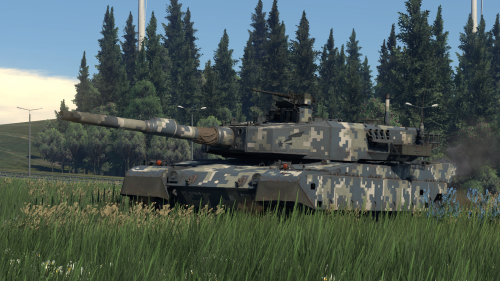
- Videos
See also
Links to the articles on the War Thunder Wiki that you think will be useful for the reader, for example:
- reference to the series of the vehicles;
- links to approximate analogues of other nations and research trees.
External links
| Japan medium tanks | |
|---|---|
| Type 97 | Chi-Ha · Chi-Ha Kai · Chi-Ha Kai TD · Chi-Ha Short Gun |
| Type 1 | Chi-He · Chi-He (5th Regiment) · Ho-I |
| Type 3 | Chi-Nu · Chi-Nu II |
| Type 4 | Chi-To · Chi-To Late |
| Type 5 | Chi-Ri II |
| Type 61 MBT | ST-A1* · ST-A2* · ST-A3* · Type 61 |
| Type 74 MBT | ST-B2* · Type 74 (C) · Type 74 (E) · Type 74 (F) · Type 74 (G) |
| Type 90 MBT | Type 90 · Type 90 (B) · Type 90 (B) "Fuji" |
| Type 10 MBT | TKX (P)* · TKX* · Type 10 |
| Other | Ka-Chi |
| USA | ▅M4A3 (76) W · ▅M47 |
| *Prototype | |
- Ground vehicles
- Japan ground vehicles
- Seventh rank ground vehicles
- Medium tanks
- Ground vehicles with composite armour
- Ground vehicles with smoke grenades
- Ground vehicles with dozer blade
- Ground vehicles with hydropneumatic suspension
- Ground vehicles with night vision device
- Ground vehicles with thermal sight
- Ground vehicles with autoloader
- Ground vehicles with gun stabilizer


